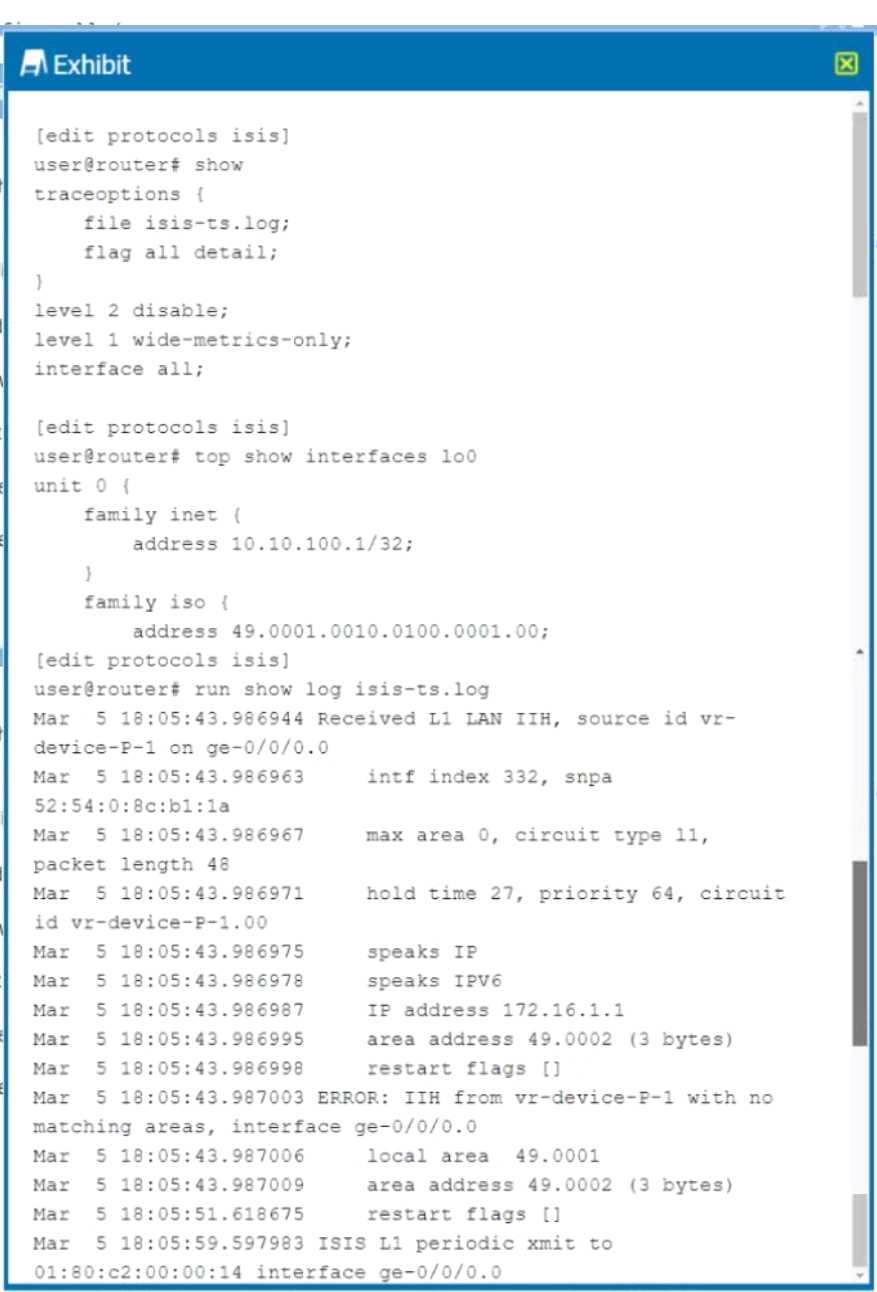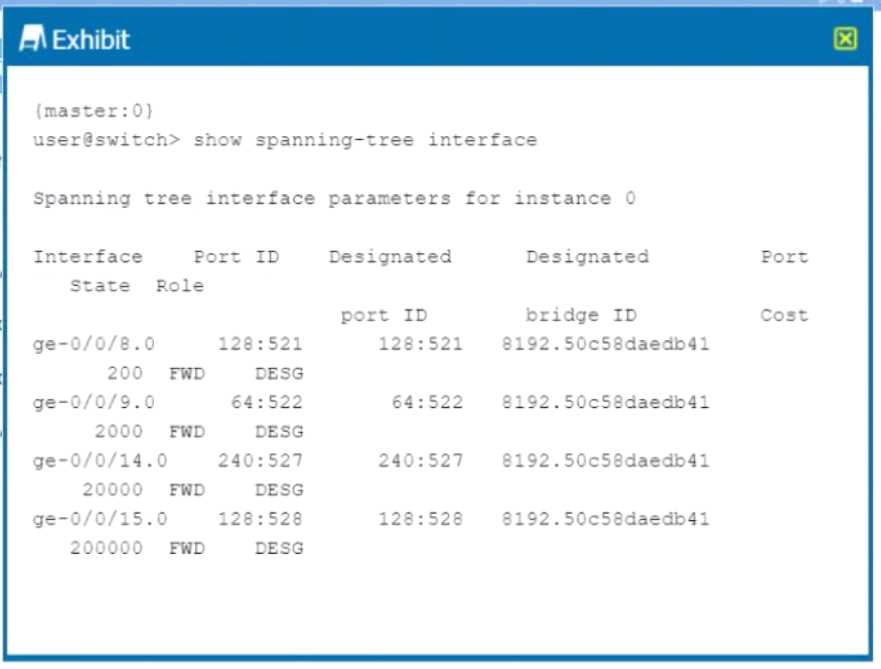Juniper jn0-349 practice test
Enterprise Routing and Switching, Specialist Exam
Last exam update: Mar 26 ,2025
Question 1
Which statement is true about IP-IP tunnels?
- A. The time-to-live value of the original packet Is decremented.
- B. IP-IP tunnels are protocol agnostic.
- C. The packet is encapsulated unchanged before entering the tunnel
- D. The packet header is replaced before entering the tunnel
Answer:
C
Question 2
Which two statements are true about high availability on Junos devices? (Choose two.)
- A. BFD is faster at detecting failures than default GRE or OSPF timers.
- B. NSR is independent of helper routers to assist the routing platform in restoring routing protocol information.
- C. NSR is dependent on helper routers to assist the routing platform in restoring routing protocol information.
- D. BFD is slower at detecting failures than default GRE or OSPF timers.
Answer:
AB
Explanation:
https://www.juniper.net/documentation/en_US/junos/topics/concept/nsr-overview.html
Question 3
What are two interarea OSPF LSA types? (Choose two.)
- A. Type 1 router LSAs
- B. Type 2 network LSAs
- C. Type 3 summary LSAs
- D. Type 4 ASBR summary LSAs
Answer:
CD
Question 4
Exhibit.
Referring to the exhibit, why is the route for 10.5.5.5 hidden?
- A. It is an L3VPN route.
- B. The next hop cannot be resolved.
- C. It has an invalid community.
- D. It is a Martian route.
Answer:
B
Question 5
Exhibit.
Referring to the exhibit, Router-1 and Router-2 are failing to form an IS-IS adjacency.
What should you do to solve the problem?
A.
Remove the overloaded statement from Router-1.
B.
Change the IP subnet masks to match on the ge-0/0/2 interfaces of both routers.
C.
Remove the ISO address from ge-0/0/2 on Router-1.
D.
Change the ISO areas on the Io0 interfaces to match on both routers.
Answer:
B
Question 6
Exhibit.
Referring to the exhibit, all users connected to the same VLAN can communicate with each other, but
not with users on other VLANs in this network.
What must be configured to enable communication between the VLANs?
- A. The switch ports to which the users are connected should be configured as trunk ports.
- B. A logical IRB interface must be created and assigned to each VLAN.
- C. A single logical IRB interface must be created and assigned to all three VLANs
- D. A separate routing device is required to forward traffic between the configured VLANs.
Answer:
B
Question 7
Exhibit.
Referring to the exhibit, which policy will export routes to IBGP peers?
- A. staric-4
- B. scatic-2
- C. static-1
- D. static.c-2
Answer:
A
Question 8
Exhibit.
Your switches are managed using Junos Space Network Director. You want to secure the switches
using a Network Director filter profile. A filter profile containing one term shown In the exhibit is
deployed to ports on managed devices.
Which traffic will be accepted by the filter?
- A. Traffic containing a destination MAC of 02:85:05:00:00:00/24 will be accepted.
- B. All traffic will be accepted.
- C. Traffic containing a source MAC of 02:85:05:00:00:00/24 will be accepted.
- D. No traffic will be accepted.
Answer:
C
Question 9
Exhibit.
Referring to the exhibit, the local router should have an IS-IS adjacency with a neighboring router,
but the adjacency never establishes correctly.
What should you do to solve the problem?
- A. Disable wide metrics.
- B. Change the local IS-IS area ID to 49.0002.
- C. Disable level 1 for the interfaces.
- D. Disable level 2 for the interfaces.
Answer:
B
Question 10
Exhibit.
You have configured OSPF routing as shown in the exhibit. You notice that all interfaces have formed
full adjacencies, with the exception of the interfaces connecting R3 and R4 with a status of 2Way.
What is the reason for this status?
- A. DROther routers will not form a full adjacency with each other.
- B. The two routers must both be configured as DR routers.
- C. The interface-type is not configured as p2p.
- D. The two routers must be configured in different areas.
Answer:
A
Explanation:
https://kb.juniper.net/InfoCenter/index?page=content&id=KB14881
Question 11
What are three well-known mandatory BGP attributes? (Choose three.)
- A. local preference
- B. community
- C. next hop
- D. AS path
- E. origin
Answer:
CDE
Question 12
You must implement filter-based forwarding. You need to direct traffic from 192.168.1.0/24 through
vr1 and traffic from 10.210.0.128/26 through vr2.
Which configuration is correct in this scenario?
- A. firewall { family inet { filter fbf-filter1 { term match-192-subnet { from { source-address { 192.168.1.0/26; } } then { routing-instance vr2; } } term match-10-subnet { from { source-address { 10.210.0.128/26; } } then { routing-instance vr1; } } } } }
- B. firewall { family inet { filter fbf-filter1 { term match-192-subnet { from { source-address { 192.168.0.0/24; } } then { routing-instance vr1; } } term match-10-subnet { from { source-address { 10.210.0.128/27; } } then { routing-instance vr2; } } } } }
- C. firewall { family inet { filter fbf-filter1 { term match-192-subnet { from { source-address { 192.168.2.0/26; } } then { routing-instance vr2; } } term match-10-subnet { from { source-address { 10.210.1.128/26; } } then { routing-instance vr1; } } } } }
- D. firewall { family inet { filter fbf-filter1 { term match-192-subnet { from { source-address { 192.168.1.0/24; } } then { routing-instance vr1; } } term match-10-subnet { from { source-address { 10.210.0.128/26; } } then { routing-instance vr2; } } } } }
Answer:
D
Question 13
Exhibit.
Referring to the exhibit, which statement is correct?
- A. The ge-0/0/15 interface is using the default port cost.
- B. This switch has a bridge priority of 8k.
- C. This switch is currently blocking all traffic.
- D. The ge-0/0/9 interface is using the default interface priority value.
Answer:
B
Question 14
Exhibit.
In the exhibit, each IP subnet in the network is associated with a unique VLAN ID.
Which action will ensure that Host C will communicate with Host A and Host B?
- A. Configure all switch ports connecting to the host devices as access ports associated with a common VLAN.
- B. Configure a port-based ACL that permits inter-VLAN routing for all configured VLANs.
- C. Configure an IRB interface for each VLAN and associate It with its corresponding VLAN.
- D. Configure all switch ports connecting to the host devices as trunk ports associated with all VLANs
Answer:
A
Question 15
You want to use filter-based forwarding (FBF) to forward traffic sourced from subnet 10.0.0.0/24 to a
specific destination.
Which two routing instance types would enable you to accomplish this task? (Choose two.)
- A. virtual routing and forwarding
- B. virtual router
- C. forwarding
- D. virtual switch
Answer:
BC
Explanation:
https://www.juniper.net/documentation/en_US/junos/topics/example/firewall-filter-option-filter-based-forwarding-example.html